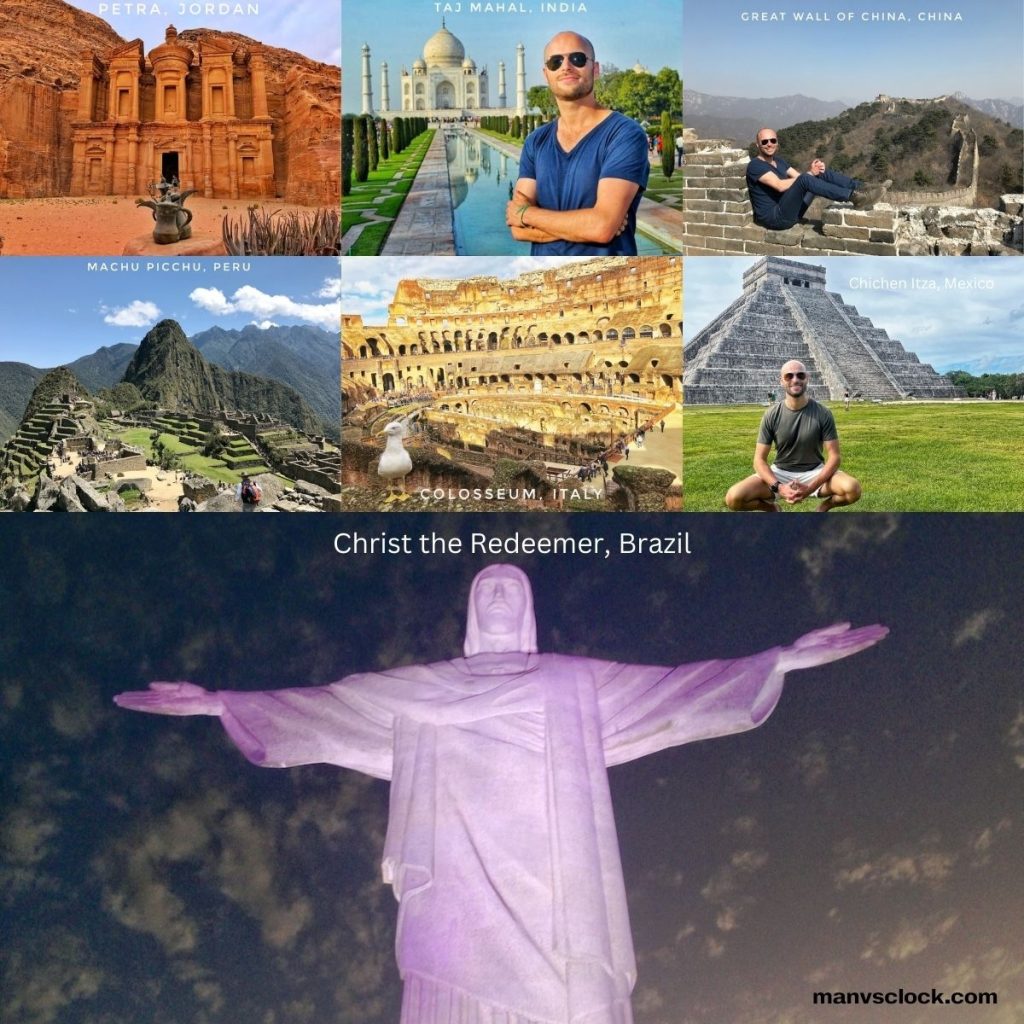Ranking the Seven Wonders of The World after witnessing them with my own eyes is a blessing that I’ll always be grateful for and hope I never take for granted.
On my 40th birthday last year, I polished off my last item on the World Wonder’s list, visiting Chichén Itzá in the Yucatán province of Mexico, a beloved country where I gladly lived for a few years.
It was the perfect swan song as I officially entered the middle-age club.
Tendonitis and tequila.
I did it my way. And I’m not sorry.
What Are the Seven New Wonders of the World?
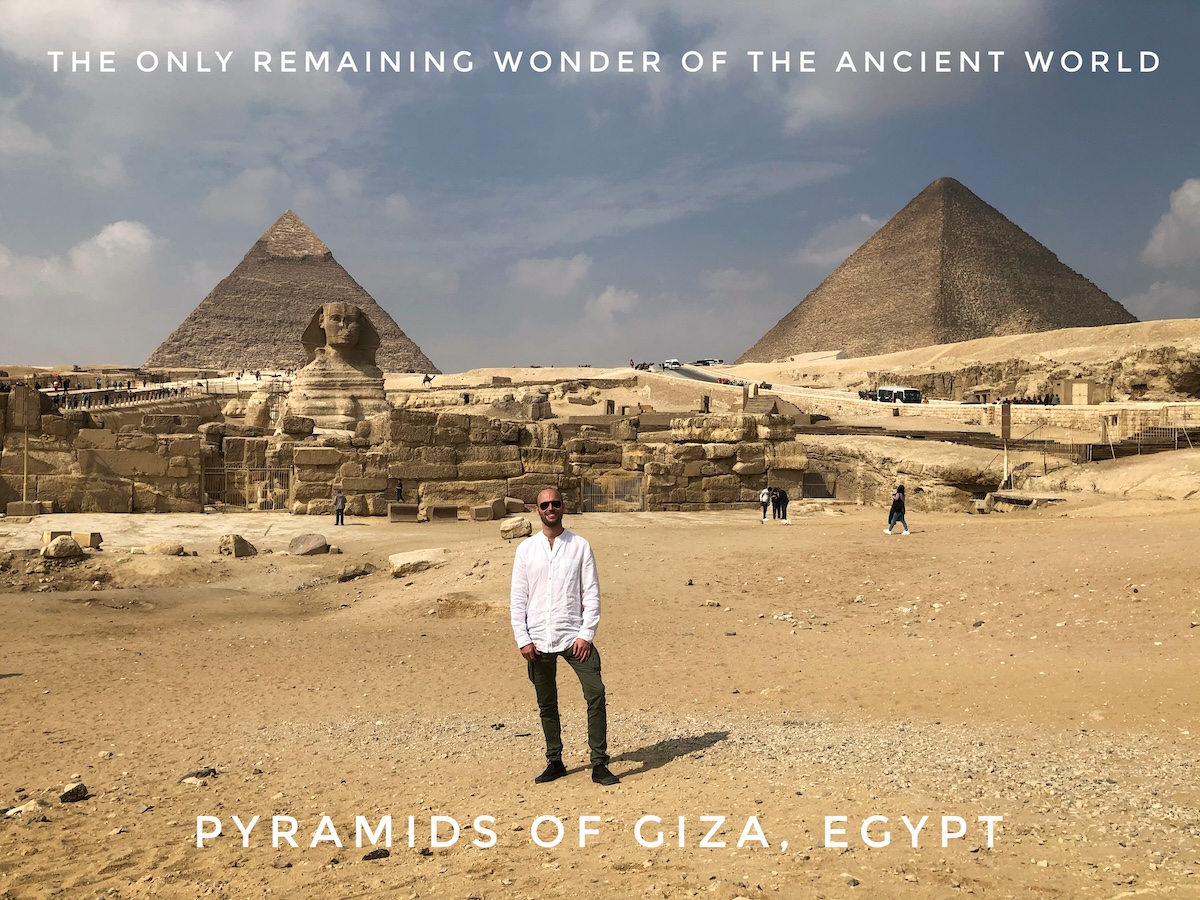
The Seven New Wonders of the World were established through an international campaign that started in 2000.
The campaign aimed to update the ancient list of the Seven Wonders of the World, of which only the Great Pyramids of Giza still exist.
Millions of people around the globe participated, casting their votes online and by telephone. The final list, announced in 2007, includes the following:
- Christ the Redeemer (Brazil) – A massive statue of Jesus Christ standing tall atop Corcovado Mountain, overlooking the vibrant city of Rio de Janeiro.
- Chichen Itza (Mexico) – A pre-Columbian archaeological site on the Yucatán Peninsula, home to the iconic step pyramid, the Temple of Kukulcan.
- Colosseum (Italy) – An ancient Roman amphitheatre in the heart of Rome, famed for its gladiatorial battles and architectural grandeur.
- Machu Picchu (Peru) – A 15th-century Inca citadel in the Andes Mountains, shrouded in mist and gorgeous scenery.
- Petra (Jordan) – A historical and archaeological city carved into rose-red sandstone cliffs, once the thriving capital of the Nabataean Kingdom.
- Great Wall of China (China) – A series of ancient walls and fortifications spanning thousands of kilometres, constructed to protect Chinese states from invasions.
- Taj Mahal (India) – A stunning white marble mausoleum built by Mughal Emperor Shah Jahan in memory of his favourite wife (lucky lass). It symbolised eternal love and created an urban myth about an unhinged way of thanking the creator.
This new list aims to celebrate remarkable human achievements in architecture, history, and culture.
However, it’s worth noting that the process was not without its controversies, as multiple votes were allowed, and governments promoted their sites, so it was a bit of a back-scratching exercise for the ballsiest of all. The shyer nations got drowned out a bit.
Very naughty.
Nevertheless, visiting these sites offers a unique journey through history, culture, and natural beauty. You must draw the line somewhere, so these were the lucky seven.
Ranking The Seven World Wonders: My System
Before I discuss my ranking of the Seven World Wonders, I want to emphasise that it is based on my personal experience, considering factors like historical significance, visual impact, atmosphere, and the surrounding travel experience.
“Worst” is a little harsh, as I thoroughly loved each experience. While each site is remarkable in its own right, I’ve ordered them from the least impressive to the best.
Not everyone will agree with my ranking because it’s my ranking based on my arbitrary system, which is as follows:
- Subjective beauty of the World Wonder. (Going off the “beauty is in the eye of the beholder” concept and all that).
- Is it worth the hype? (Based on whether it lived up to its name for me).
- Sentimentality (The most personal one on the list, based on my precious emotions).
- Other things to do around the area. (Are there cool things to do other than the Wonder? We all want to be there for the main event, but it gets bonus points if it’s in an area with extra activities on your trip).
7. Christ The Redeemer, Brazil

LeBron James is so famous that he managed to eclipse the main man himself, Jesus Christ.
Pragmatically, queuing to see a world wonder during a football World Cup in a densely populated nation is always an extra challenge. But with an American basketball superstar visiting at the same time as us, it was downright manic
Aside from LeBron’s World Wonder-blocking, the statue itself is pretty impressive. Still, in my opinion, it is not good enough to be on the list of seven and, quite frankly, is a slap in the face to a genuine man-made marvel like Angkor Wat in Cambodia.
That said, we had a good time, and a scalp is a scalp. We, of course, did “the” pose with arms stretched out for our photo to cement our status as basic bitches of Brazil.
Why It’s Ranked Here: I visited Christ the Redeemer during the 2014 World Cup with my best mate from back home, reconnecting after three years apart. So it certainly gets the sentimentality nod.
Rio is a fun city to spend a few weeks in; Brazil is a passionately Christian nation, so seeing the Jesus statue, considering how much this means to locals, was a fantastic experience.
Sadly, someone has to be last on the list, and considering its lack of nuance in its artistic beauty, Christ the Redeemer has a lot of redeeming to do to make it higher on my list.
How to Visit Christ the Redeemer: The best way to visit Christ the Redeemer is by taking the Corcovado Train, which offers a scenic ride through Tijuca Forest to the top. You can also opt for a van service or hike if you’re up for a challenge—book tickets in advance to avoid long queues, especially during peak season.
For the best experience, visit early in the morning or late afternoon to avoid crowds and capture the stunning views in the best light. Try to go on a clear day for optimal views of Rio below, as clouds can block the statue and scenery.
Safety-wise, stick to well-known transportation options and avoid flashing valuables in Rio. Christ the Redeemer is relatively safe, but be cautious in crowded areas and monitor your belongings.
Bring sunscreen, water, and comfortable shoes, as there will be some walking once you’re at the top.
Other Things to Do After Visiting: Rio de Janeiro has plenty more to offer after visiting Christ the Redeemer. Head to Sugarloaf Mountain for another iconic viewpoint. You can take a cable car and enjoy panoramic views of the city, beaches, and ocean.
If you’re into history and culture, the Selarón Steps in the Lapa neighbourhood is a colourful mosaic masterpiece, perfect for a quick stop and some memorable photos. You can even turn your favorite shots into photo books to remember the trip.
Or, if you want a more immersive nature experience, explore Tijuca National Park, which surrounds the Christ the Redeemer statue and offers hiking trails, waterfalls, and wildlife.
6. Chichen Itza, Mexico
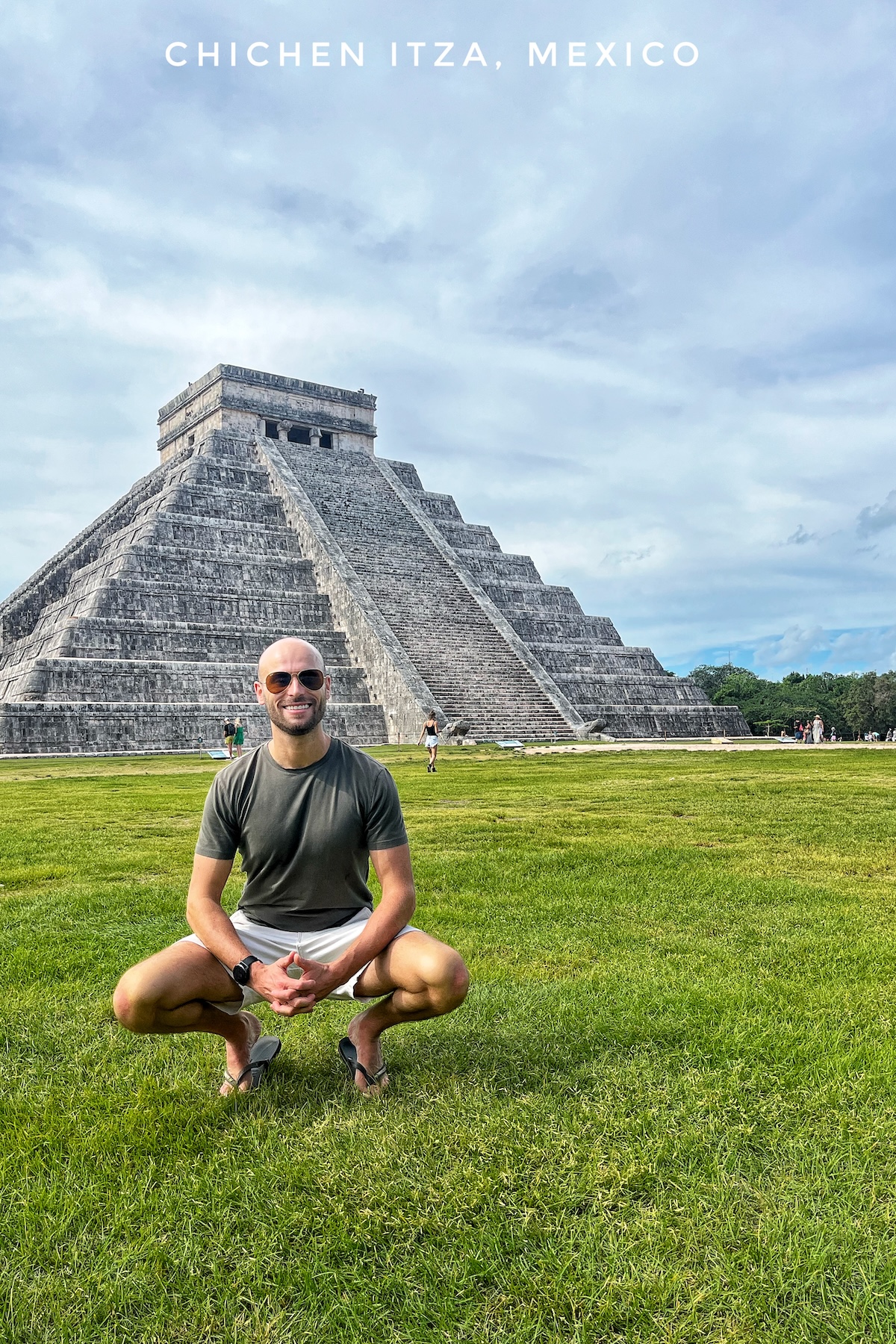
I don’t usually hire tour guides unless it’s an exception, and on this occasion, I had perfect reason to.
You see, I knew that good Anthony had pure intentions, but I also knew that bad Anthony would more than likely get too drunk on the eve of his 40th birthday.
I have to be one step ahead of that bastard.
Good Anthony is punctual and doesn’t like to break promises, so I knew if I had to be on time for someone, I’d make it early and not waste any time on my one shot at the final world wonder on my list.
Also, I was due to do a best man’s speech in Mexico in English and Spanish the week after, so I hired a local Mexican lady who took the piss out of hungover me in español while explaining the fascinating and often brutal history of Chichén Itzá, arguably the most famous of Mexican landmarks.
Don’t get me wrong; I loved visiting Chichen Itza, Mexico’s iconic historical site. It’s not the best of the lot, but the history of the civilisation that built it was interesting, and for me, it was a worthwhile trip.
Why It’s Ranked Here: The atmosphere was admittedly a bit “touristy.” I always feel so wanky saying things like this. After all, I am literally a tourist myself, and everyone else has as much right to be there as I do.
But you know what I mean.
Travel is somewhat of a drug, and once you’ve tasted the class-A stuff, the softer options don’t tend to have the same buzz.
Also, when it’s too touristy (that’s twice I’ve used that word now; I may be sick in my mouth), it takes away the place’s mystique. Obviously, as the last World Wonder for me on my 40th birthday, it gets the hat tip to nostalgia when I’m boring those eye-rolling nurses on my deathbed. Still, with a heavy heart, it doesn’t quite make the grade on my list due to the other five icons left on the list being so wonderful.
How to Visit Chichen Itza: Many tourists opt for the tiring early morning rush from Cancun to Chichen Itza, but a much better way is to stay in the charming town of Valladolid, just 40 minutes from the site. This colonial town is full of history and offers a far more relaxed experience than the crowded “Woop-Wooping” spring breakers partying in Cancun.
In the evening, don’t miss the light and sound show at Casa de los Venados, where the town’s history is projected onto the walls of a beautifully restored building. Staying in Valladolid allows you to visit Chichen Itza at your own pace, either early in the morning or late in the afternoon, avoiding the rush of tourists.
Plus, you’ll have time to explore nearby cenotes like Cenote Zací, located right in town, and get a real taste of Yucatán culture. Ditch the Cancun chaos and enjoy the laid-back charm of Valladolid as your base for Chichen Itza.
Other Things to Do After Visiting: I think I’ve already answered this: skip Cancun (or add it to your itinerary if you have the time to spare) and base yourself in Valladolid instead.
5. Colosseum, Italy
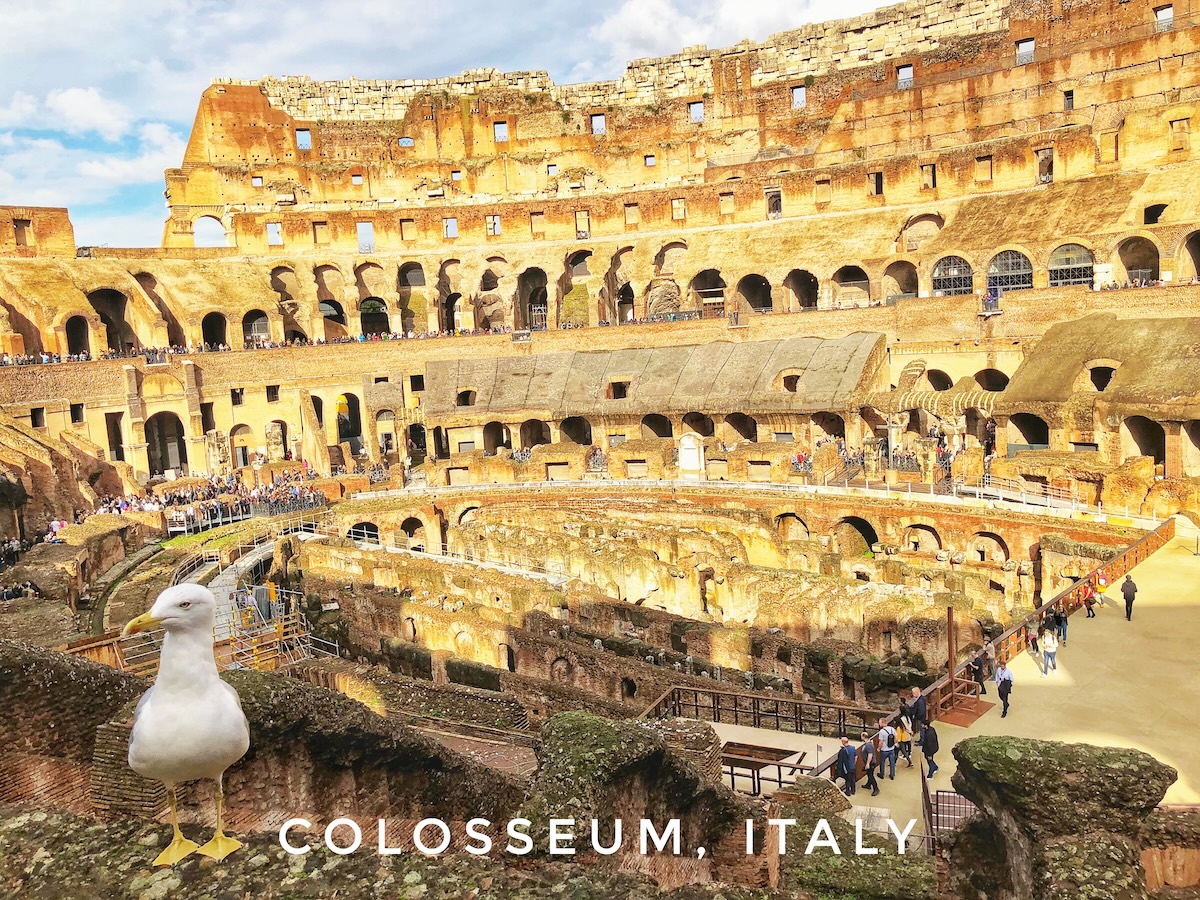
In at number five is the Roman Colosseum: Mama Mia! What a beauty.
I had a long flight connection (16 hours) from Rome to Rio de Janeiro. Sipping on an Italian espresso that was way too strong for my pathetic tolerance, I opened up my laptop at the airport to catch up on some work; luckily, as soon as the drink touched my lips, I thought to myself, “What the hell am I playing at?”
I was in Rome, one of the most famous cities on earth, housing one of the Seven World Wonders, copious amounts of culture, and a plethora of delicious food and red wine.
It was around 5 am, so I had time to beat the queues. Dressed like a bag of crap, considering I was in comfy aeroplane clothes, I braved it into the city where it seemed every man looked like a bloody Armani fashion model.
As soon as I entered, it became easy to avoid eye contact with my shameful attire. The Colosseum requires a lot of scaffolding to maintain. Still, when you look at it from a good view and take it all in, it’s a lasting testament to early human ingenuity and, of course, a relic of barbaric cruelty from another time.
After that, I spent ample time in Vatican City, the smallest country in the world, before grabbing a pasta arrabbiata that made my heart weep like it had just heard Andrea Bocelli belt out “Time to Say Goodbye” for the first time.
With a satisfied belly and an even more fulfilled sense of achievement, I returned to the airport, ready for my trip to Iguazu Falls. I felt like I had the world at my feet.
Why It’s Ranked Here: Italy has it all in terms of culture and thoroughly deserves to be one of the world’s most visited countries. I find something different that I love about Italy every time I go, and the Colosseum stands very pretty in Rome.
The impromptu nature of this trip had the chance to bump it up the list a bit as it added a romantic element, but it’s up against some heavy hitters on this list.
How to Visit the Colosseum: Visiting the Colosseum in Rome is essential if you are going for all of the World’s Wonders, but a little preparation can go a long way. Book your tickets with an attractions pass in advance online to avoid long lines. You can also buy a combined ticket that includes access to the Roman Forum and Palatine Hill, which are right next to the Colosseum and offer a great look into ancient Roman history.
Once inside the Colosseum, take your time exploring the different levels and imagining the gladiatorial games that once captivated frenzied crowds here. After your visit, head to the Roman Forum, a collection of ruins in ancient Rome’s heart, and Palatine Hill for stunning views over the city.
The best time to visit is during the shoulder seasons of spring (April to June) and fall (September to October), when the weather is pleasant and the crowds are thinner compared to the summer months. Early mornings or late afternoons are ideal for avoiding the peak rush.
Other Things to Do After Visiting: For a completely different yet iconic experience, visit Vatican City, the world’s smallest independent state. As a European micronation, it’s home to St. Peter’s Basilica and the Vatican Museums, where you can marvel at Michelangelo’s Sistine Chapel and countless other pieces of art.
The most convenient option is the Metro. Take Line B toward Laurentina from the Colosseo station and change from Termini to Line A toward Battistini. Get off at the Ottaviano-San Pietro station, just a short walk from St. Peter’s Square and the Vatican Museums. The entire journey takes around 20-25 minutes.
Alternatively, you can take a taxi or grab an Uber for a direct route, which typically takes about 15-20 minutes, depending on traffic. I also took the option of walking, though it’s a bit longer, taking around 45 minutes, but it allows you to explore the streets of Rome along the way.
4. Petra, Jordan
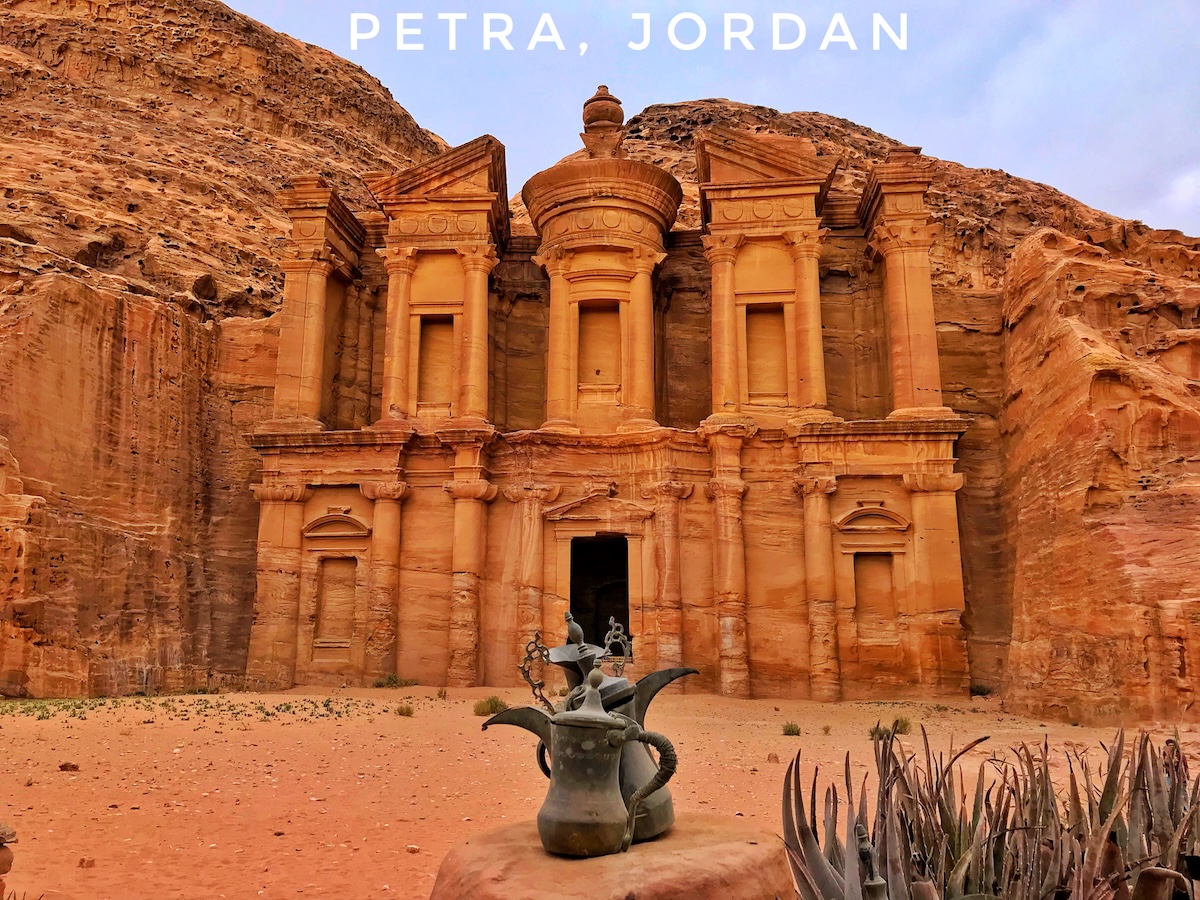
As a longtime sufferer of high-expectation syndrome, a visit to Petra was getting bigger and bigger in my head. I loved my first visit to Jordan after camping with Bedouins in the desert, staying in a delightful hotel in Aqaba with a perfect view of the Dead Sea, and driving from Wadi Rum to the much-awaited Petra.
The place was absolutely massive, and (travel cliché warning) it genuinely felt like walking into another world. I swear that wasn’t the bangin’ Bedouin tea talking.
Wandering deeper into Petra with tombs and temples seeming out of nowhere, carved directly into the towering cliffs as docile camels with their slow, deliberate pace framed by the deep blue sky and the endless desert was everything that I hoped it would be.
Why It’s Ranked Here: This might sound like a weird thing to say, as everywhere outside of your own culture is technically “exotic,” but I sure as hell feel the culture shock when I’m in the Middle East. As a big fan of cinema, visiting Petra was like walking straight onto the set of Indiana Jones and the Last Crusade.
Seeing the Treasury in person, which was famously featured as the hidden temple in the film, was what I signed up for. I half-expected Harrison Ford to come charging out with his fedora and whip with some thankful fair maiden hanging off his arm.
How to Visit Petra: The best way to experience Petra is by arriving early in the morning, ideally at sunrise. This allows you to avoid the crowds and walk through the Siq, the narrow canyon leading to the Treasury, while it’s bathed in soft, golden light. The early morning glow enhances the dramatic beauty of the rock formations, and you’ll have more quiet time to take in the stunning surroundings.
Petra requires a lot of walking, so wear comfortable shoes and bring plenty of water. If you’re feeling adventurous, consider hiking up to the Monastery, which offers lovely views and is less crowded than the Treasury. It’s a bit of a climb, but that extra sense of discovery is worth it.
Buying your tickets in advance or opting for a multi-day pass is also a smart move, as there’s a lot to see, and you may want more than one day to explore the site fully. If possible, plan your visit to coincide with Petra by Night, an event where thousands of candles illuminate the Treasury.
Other Things to Do After Visiting: After exploring Petra, plenty of nearby attractions are worth visiting. Just an hour or so away is the incredible desert landscape of Wadi Rum, often called the “Valley of the Moon.” You can take a jeep tour or spend a night in a Bedouin camp under the stars, offering a truly unforgettable experience.
Another option is to head to the Dead Sea, which is about a three-hour drive from Petra. Floating in its salty waters is a unique and relaxing experience, and it’s a great way to unwind after hiking through Petra.
3. Great Wall of China, China

This one usually raises a few eyebrows. Putting it so high on the list can be divisive, as many have had frustrating experiences visiting this mammoth of a World Wonder.
Not only is it incredibly famous, but you’re in a country with over a billion people (many of them incredibly nationalistic) and the starry-eyed tourists who have come to see the Great Wall of China… that’s quite a lot of traffic to contend with.
I don’t mean to sound cocky, but I knocked this one out of the ballpark by doing my research prior and, in my opinion, got to visit the best section to see the Great Wall of China, known as ‘The Wild Great Wall.’
I had many parts of the wall to myself and the hike in nature was just what I needed to decompress after spending 4 days in North Korea. Much like Jordan, I had enjoyed my first visit to China and seeing the Great Wall was the cherry on top of a very sweet cake.
Why It’s Ranked Here: There was every chance this could have been a big anticlimax due to the prestige of the name and the probability that the experience would be ruined for me by numbers alone.
I am proud of the research I did. I managed to pull it off on the day and had sections of the Great Wall of China to myself for the most part. It was phenomenal.
How to Visit the Great Wall: My comprehensive article (Best Place to See Great Wall of China (No Crowds, No Worries!) explains why people have such a rough time when they visit the Great Wall, how to avoid that disappointment, and provides firsthand advice on getting the most out of your trip to this prodigious World Wonder.
Other Things to Do After Visiting: The most famous highlight after the Great Wall is Beijing’s Forbidden City, a massive palace complex home to Chinese emperors for centuries. It is located in the city’s heart and offers a deep dive into China’s imperial history. I must be honest – I found it massively overrated, but that’s your decision and opinion to earn if it’s on your list.
Afterwards, you can stroll through Tiananmen Square, which is nearby and packed with dark historical significance.
For a more modern experience, wander around the trendy 798 Art District, where you’ll find galleries, cafes, and shops showcasing contemporary Chinese art. Beijing’s mix of ancient history and modern culture provides pleasant bonus opportunities for exploration beyond the Great Wall.
2. Machu Picchu, Peru
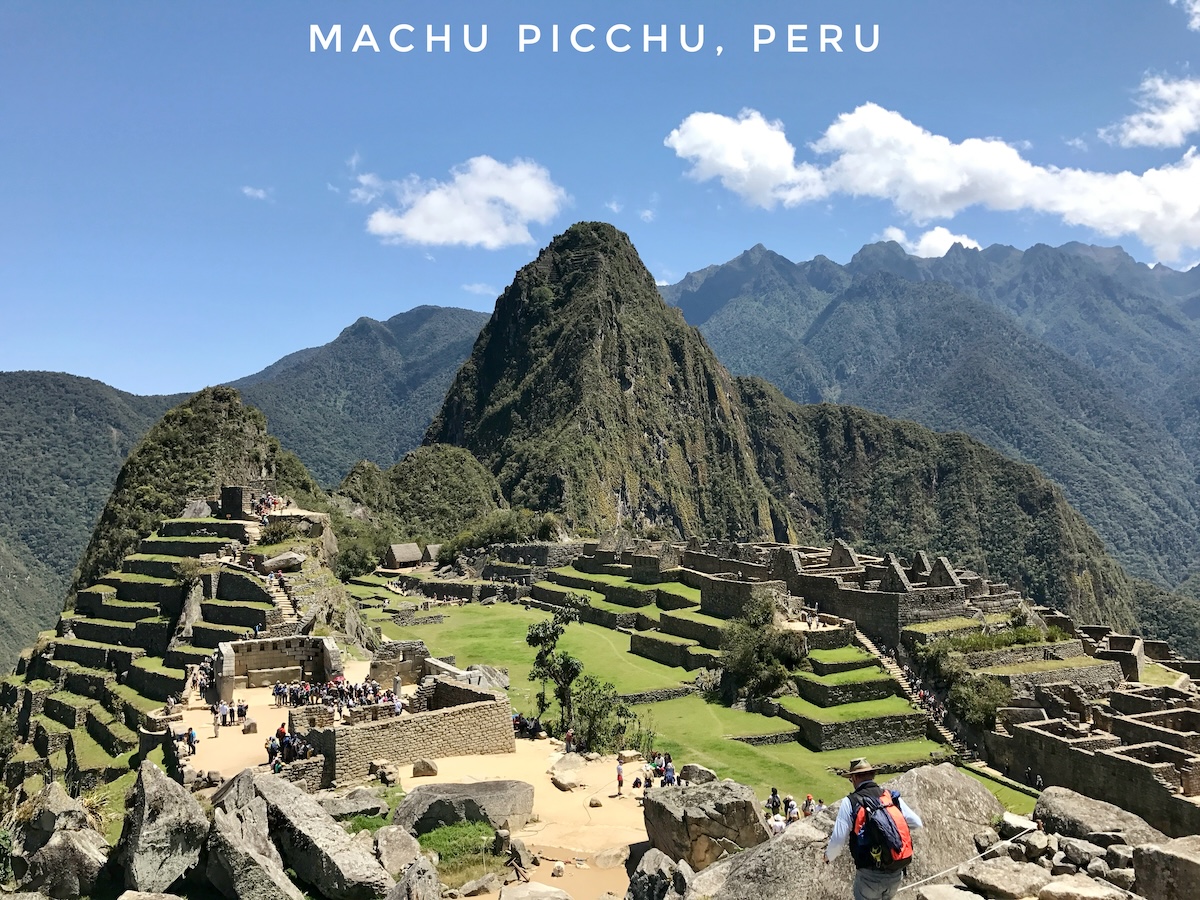
Visiting Machu Picchu was something I had always dreamed of since my cousins made the Inca Trail almost two decades before.
Back then, I held the self-limiting belief that “people like me” didn’t get to see things like this unless they were from behind a TV screen.
As mentioned above, my friend from my Brazil trip had visited the week before and leaned into my competitive nature by hiding a specific tree branch for me to find en route to Machu Picchu from the nearby town of Aguas Calientes. I found it… (Obvs) and marched onto the Peruvian landmark, which kept getting better and better as I continued walking forward.
The moment I saw the ancient citadel emerge from the fog, I couldn’t get my head around how something so remote, so beautifully crafted, could have been built centuries ago without modern technology.
The deeper I walked into the site, the more it amazed me and tickled my imagination—the precision of the stonework and the surrounding mountain peaks in the misty Andes. Thankfully, it was one of those rare moments in travel when reality equalled (or possibly exceeded) the dream.
Oh, and there were llamas and alpacas, too, tended to by locals in their traditional clothing. It felt fantastic to tick off another World Wonder and a few species off my weird animal wildlife bucket list at the same time.
Why It’s Ranked Here: This was my second time travelling through South America. It added profound layers to my experience since learning Spanish in Medellin after living there for nine months before moving to Mexico for an extended stay.
Being able to converse with locals on a deeper level and exploring more of Peru is honestly enough to have this experience as number one. Alas, it bulldozes its way onto the podium with a very respectable silver medal.
How to Visit Machu Picchu: There are two main ways to reach Machu Picchu: hiking the Inca Trail or taking the train from Cusco.
The Inca Trail is the more adventurous option. It offers a four-day trek through stunning Andean landscapes and ancient Inca ruins, culminating in your arrival at the Sun Gate for a breathtaking view of Machu Picchu. Permits for the trail are limited and must be booked months in advance, so plan if you choose this route.
If you prefer a more relaxed journey, take the train from Cusco or Ollantaytambo to Aguas Calientes, the gateway to Machu Picchu. The train ride is scenic, winding through the Sacred Valley with views of the Urubamba River and towering mountains. From Aguas Calientes, it’s a short bus ride or a steep hike up to the entrance of Machu Picchu (this is what I did).
It’s best to book tickets for Machu Picchu in advance, whichever route you choose, especially during peak seasons. Arriving early in the morning or late in the afternoon will help you avoid the largest crowds and allow for a more peaceful experience at this iconic site.
I wrote a detailed post on the ins and outs of this, which was ingeniously titled: How To Get To Machu Picchu From Cusco (No Dramas, Only Llamas!)
Other Things to Do After Visiting: After you visit Machu Picchu, take the opportunity to explore more of the Sacred Valley—Ollantaytambo, where most travellers board or depart the train to Machu Picchu. While you’re there, you can visit the ancient Inca fortress and take a side trip to the Maras Salt Mines, a fascinating network of salt ponds that have been in use for centuries.
From there, head back to Cusco, where you’ll find even more historical and cultural treasures. Wander through the bustling Plaza de Armas, the heart of the city, and don’t miss a visit to Sacsayhuamán, an impressive Inca fortress with panoramic views of Cusco.
I highly recommend a day trip to the Rainbow Mountain and the Red Valley from Cusco. These colourful landscapes are unlike anything else, and many consider them one of the true highlights of their trip to Peru.
Beyond the Cusco region, Peru offers a range of incredible destinations. Explore the desert oasis of Huacachina, go sandboarding on its dunes, or visit Arequipa and the stunning Colca Canyon, one of the deepest canyons in the world.
1. Taj Mahal, India
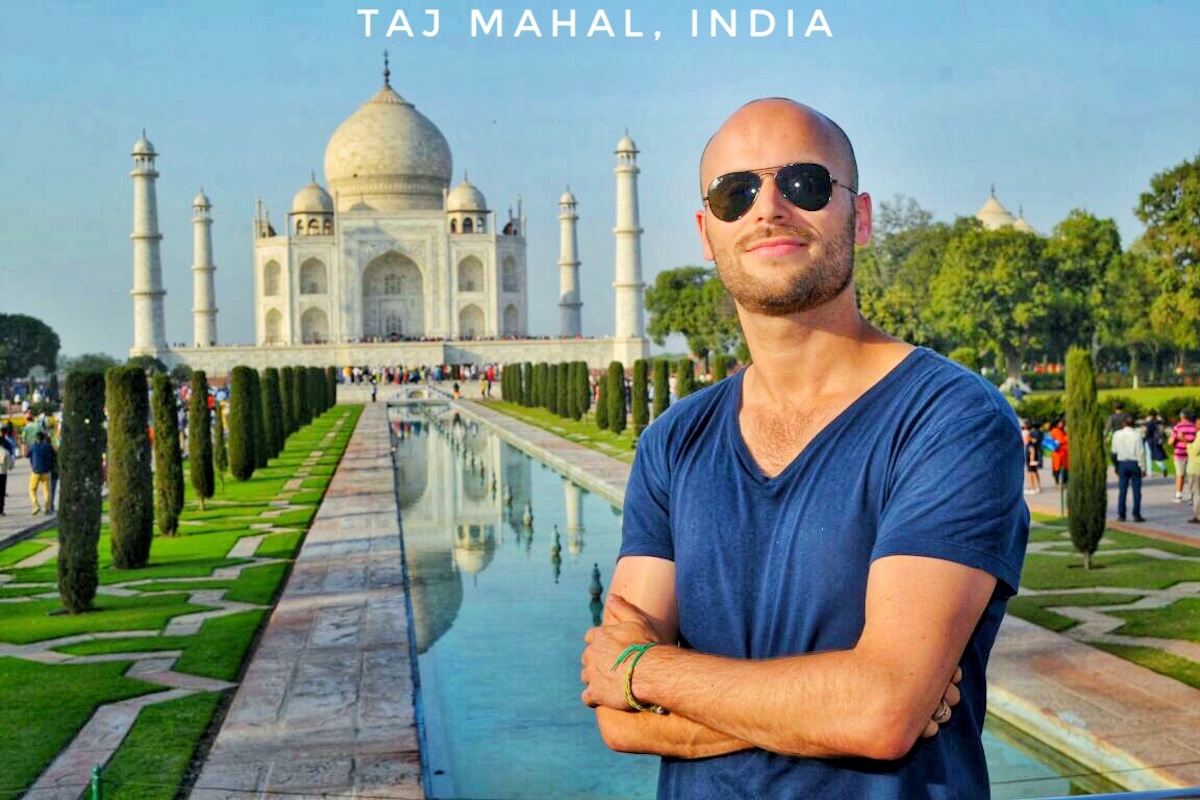
Have you ever had one of those glorious days on the road when everything just falls into place perfectly?
I did when I went to see The Taj Mahal, and I left Agra feeling very smitten.
Like the Great Wall, it’s ridiculously famous and has a population of over 1 billion people, so the odds of a perfect day are against you on most days. I got there so early that I even beat the hardcore, punctual Japanese tourists!
I didn’t waste any time when I was given the nod. As I walked through the archway and caught my first glimpse of the gleaming white marble, it almost didn’t seem real. The symmetry, the reflection in the surrounding pools, and how it seemed to float above the haze of Agra’s chaotic streets made it feel like I was stepping into a picture-perfect postcard.
I’m no architecture savant, but I’m also not a complete philistine, and I know a beautiful building when I see one.
Speaking of which, I’ve never been too talented at photography and as much as I was taken in by the moment, a thought danced across my mind that it would be a real shame if I messed this one up!
When the thought entered my consciousness, a pushy local man with a large camera asked me if I wanted to use his services. He seemed shocked as I said yes, negotiated a price, and asked about the best places to get photos of the building and myself. Of course, he was used to this, and I think he did a grand job.
The main photo is one of my favourite photos of me because the smile on my face is as genuine as they come.
It’s always a little awkward smiling in every single photo, but I can almost feel the gratitude I felt on this day. There I was… me—at the world-famous Taj Mahal after a wonderful six-week India itinerary.
Number one on a list of worthy winners. Thank you, and good night.
Why It’s Ranked Here: As mentioned earlier, it was one of those days when everything came together, like the universe conspired to work in my favour at all costs. I recently learned that the word for that is ‘Pronoia.’ I think many of us would enjoy reframing our lives with a nice little self-diagnosis of pronoia and working hard to prove it right.
The beauty of the building and the Jawab alongside it was spectacular. I was already a travel veteran at this point, and it completely seduced me.
I also lucked out a bit with the timing of the crowds and the photographer. I appreciate that, and this was truly a perfect visit for me.
How to Visit the Taj Mahal: The best time to visit the Taj Mahal is at sunrise when the light is soft, the air is cooler, and the crowds are much smaller. Arriving early allows you to experience the serenity of the monument before the busy tourist hours begin. The early morning light also enhances the beauty of the white marble, making it an ideal time for photography.
Book your tickets online in advance to avoid long lines, and be sure to plan for security checks upon entry. Once inside, take your time exploring the complex, including the Mehmaan Khana (Guest House) and the Jawab, which are located beside the main mausoleum.
Consider accepting the offer of a paid service for photos by one of the guys with the large cameras. You can’t miss them, they’re rather pushy! Schedule a second visit around sunset for a completely different atmosphere, as the fading light transforms the monument with a warm, golden hue.
Be mindful of the strict rules regarding what items can be brought inside (food, tripods, and large bags are not allowed).
Other Things to Do After Visiting: Just a short distance from the Taj is Agra Fort, a UNESCO World Heritage site. This massive red sandstone fortress offers a glimpse into India’s Mughal history, with stunning palaces, courtyards, and magnificent views of the Taj Mahal from its embankment.
For a more in-depth exploration of Mughal architecture, take a day trip to Fatehpur Sikri, a beautifully preserved ghost city about an hour from Agra. The complex, built by Emperor Akbar in the 16th century, boasts impressive mosques, palaces, and courtyards. Though abandoned after just a few decades, it remains a testament to the grandeur of the Mughal Empire.
While in Agra, consider visiting Sheroes’ Hangout, a pay-what-you-can café that supports women who have survived acid attacks.
The café, located near the Taj Mahal, provides employment opportunities to these survivors, empowering them while raising awareness about violence against women. Sheroes’ Hangout offers delicious local cuisine, such as Vegetarian Biryani, Dal Tadka and Paneer Butter Masala. It also serves as a hub for activism and education, making it a meaningful stop for visitors who wish to contribute to a positive cause.
Ranking The Seven World Wonders: Final Thoughts
I seem to have a perverse addiction to forcing myself to answer “favourite” list categories, with the tyrannical quizmaster also being myself.
I don’t recommend it.
Ranking the Seven World Wonders is an honour. I accept most counterarguments against my list because I know that deep down, it’s not just me who prioritises the feeling on the day of the experience above all other factors.
However, the constructions’ beauty and historical significance are valid reasons to have a completely different list if that’s your preference.
How does your list look if you have also completed the Seven World Wonders list (or a decent chunk of it)?

